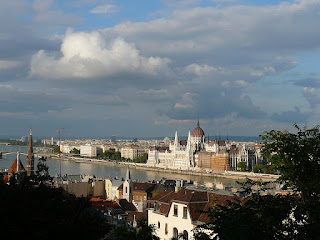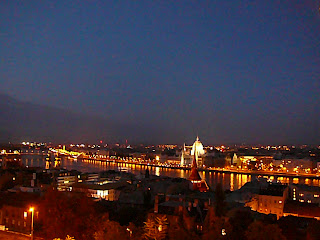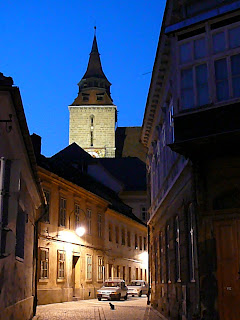
The previous day, as we walked around Margaret Island, I noticed that Sarah had a couple of red bug-bite like welts on her forehead. I asked about them, and she pointed out that she had a few more on her arms. Later that evening, we looked at them some more, and decided that she was probably having an allergic reaction to something. Maybe the detergent that had been used to clean her clothes last time had caused the reaction.
Then, surprisingly, the next morning she had a few more bites. To make matters worse, I had a couple on my back, and a dusting of them on my arm. If they were an allergic reaction it would be odd for both of us to have it. So, of course I start to pretend I'm a Doctor. My diagnosis:
Bed bugs.
Bed bugs are one of the Boogey-Men (or, rather, Boogey-Bugs) of the budget traveller's world. Supposedly common in dirt-bag hotels, they are the type of thing that is easy to catch and difficult to get rid of. Our theory was that we'd got them from the hostel we'd spent the first night, and carried them with us to the new one.
Dutifully, the girls who worked at our new hostel stripped our bed of linen. And then washed all of our laundry for us. In the meantime, Sarah and I made the rounds to the pharmacy to pick up anti-itch cream, and then hit the internet cafe to do "research" on beg bugs (see link above for the extent of our research). Then, returning to our room, we went through our bags from top to bottoms looking for "bug signs."
In the end, it probably wasn't bed bugs. Fleas from
Darko? Maybe. Rogue mosquitoes? Possibly. Anyhow, two days later, we've had no additional bites; and the ones we did have are now all but faded away.
Still, between that and acquiring train tickets, that day was pretty much written off. We did manage to have a nice dinner in a tiny restaurant lined street, but beyond that the day was sadly a loss.
This brings up a quick annecdote about Budapest:
As we left the Internet cafe that day, we pulled out a little pocket map to try to get our bearing really quick. As we did, an old lady spotted us and came across the street. "Hungarian? German?" She asked, wondering if we knew either language.
"Klein Deutsch. Sehr klein." I responded, trying to recall my High School German.
She seemed to be lost, and wanted to look at our map. We showed it to her, and in broken German, I started pointing out streets to her. She, in turn, pointed at streets and named them off, nearly repeating what I had said.
Then, she asked about our hostel. I presumed that maybe she was looking for a place to stay, so I said what our hostel was, but explained it was very cheap and for backpackers.
She then repeated the directions on how to get to our hostel. And, also in broken German, began taking about what a big and confusing city Budapest is. I agreed. Trying to be helpful, Sarah ducked back into the internet cafe and grabbed another copy of the free pocket street map we had. She handed it to the woman, who seemed confused and tried to give it to us.
Eventually, she shrugged, took the map. Wishing us a good day, she turned and made her way back down the street. Only then did I realize: She wasn't asking us for directions... she thought we were lost, and was trying to
give us directions.
And,
that is Budapest in nutshell.
Anyhow, the following morning, we didn't have any additional bug bites, so we decided to "turn this town around." So, packing our day pack with towels and bathing suits, we made our way to one of Budapests many famous public baths.
As Sarah observed: "Its a good thing that the Ottoman's invaded Hungary, and not- say- the British. Or else there wouldn't be all these wonderful baths." The city of Budapest sits on top of hundreds of natural thermal springs. And, many of them have been turned into giant public bathhouses, with purportedly medicinal and theraputic value.
So, we made our way up the famous Andrassy Street to where the Szechenyi Baths are located in Varosliget Park. On the way, we were able to stop and check out several notable sights in the area, such as Heroes Square and the Statue of Anonymous.
 Some of the incredible, but run-down buildings that line Andrassy street.
Some of the incredible, but run-down buildings that line Andrassy street. Some of the statues that are part of the giant Heroes Square Monument.
Some of the statues that are part of the giant Heroes Square Monument. The statue of Anonymous. It was actually hard to get a photo of him because other people kept climbing onto his lap to get their picture taken.
The statue of Anonymous. It was actually hard to get a photo of him because other people kept climbing onto his lap to get their picture taken.The baths themselves are located in a massive Neo-Baroque complex. They are built on top of the deepest and hottest hot springs, and are probably the most famous baths in Budapest.
Paying our entry fee, we made our way into the locker room, where we were given a small closet to change into our bathing suits. After that, we were set free to explore the wide range of pools and saunas the baths offered. Each pool was at a different tempurature, including several large outdoor pools which also included fountains, swuirling jets and other features.
Not unlike our visits to
Banya 5 in Seattle, Sarah and I quickly settled into a routine: Sit in a steam room and sweat, plunge breifly into a cold water pool, relax for a while in a hot pool, and repeat. Leaving the baths about to hours later, we felt like neithe rof us had a mucle left in our bodies.
Outside, we bought large cheese pretzels and some water, which we enjoyed on a park bench. The day was summer and bright with a brisk, yet playful, breeze; and we were both feeling much better than we had the previous day.
Stopping to drop off our wet suits at our apartment, we grabbed a quick bite to eat at a pub, and then made our way to the National Museum. They were having an exhibit on the Mongol invasion of Hungary, and we thought it would be a good way to get our heads around some of the countries history.
After learning about the Mongol invasions (which involved a lot of lines like "their swords would not thirst for blood that night"), we made a quick tour of another section featuring artifacts from the last hundred years of Hungarian history. Unfortunately, we only had a short time left before the Museum closed, so we rushed through it, viewed the Coronation Mantle and made our exit.
Since that would be the end of our last full day in Budapest, we decided to end the day on a good note, and enjoy a fancy meal. Oddly, on the day we'd arrive, the man working at our hostel had recommended the restaurant to us. But, when we'd peaked through the windows that first day, we realized that he must have missed our request that restaurant be "cheap." But, on our final night in Budapest, we figured we could treat ourselves.
Sadly, while the ambiance was nice, the food wasn't the best we'd had. Still, it made for an enjoyable evening, and after dinner we stopped by a pub for a beer and glass of Unicum (the national liqour).
This morning, we got up, packed and checked out of our hostel. Our train will depart at 8:30pm, so we had the day to do some last sightseeing. Catching the metro up to Castle Hill, we went inside St. Mattias Cathedral. The outsides are currently being renovated, so they're not much to look at, but the interior is filled with deep red and green Art Nouveau painting.
 The outside of the church was covered in scaffolding, but the inside was still impressive.
The outside of the church was covered in scaffolding, but the inside was still impressive.After that, we wandered down the quaint and quiet Lord's Street, before ducking into the Labyrinth. In addition to providing the wonderful thermal baths, the underwater springs have carved a network of tunnels beneath Budapest. These tunnels have been used at various times for everything from bunkers to cellars. Sarah and I paid our admission and wandered around the networks of tunnels which make up the Labyrinth.
Many of the tunnels have been turned into various artistic interpretive pieces. And, whicl some (like the Test Your Courage Tunnel) are effective, others (featuring reproductions of cave painting from other parts of Europe, for example) are just distracting.
After reemerging into the daylight, we made our way down off Castle Hill, and across the Danube. We stopped breifly at Budapest's largest synagogue (the second largest in the world), and took a look at the Holocaust Memorial. During WWII, 600,000 Hungarian Jews were killed in the Holocaust. The memorial is a large metal weeping willow tree. Each of its leaves is engraved with the name of someone who lost their life in the Holocaust. As we made our way back to the street, Sarah and I agreed it was surprisingly moving and affecting.
 The Holocaust Memorial outside the synagogue.
The Holocaust Memorial outside the synagogue.After that, we made our way to the Internet cafe... which brings us to here and now. This will probably be our last entry on Strange and Benevolent before we return to the States. Tonight, we board a train to Munich, where we will spend one day before flying home. It's been a long and amazing ride (not to mention and strange and benevolent one), and we can hardly beleive that it is already almost over.
But, that said, this definitely isn't our last entry here. Hopefully, after we get back, we'll bring everyone up to speed on how our last day went, as well as our trip home. In addition, we both want to do some post-trip entries covering everything from how it feels to be home again, what we have (or haven't) learned and even talking about our packing choices and how we'd do things different if we did them again.
Thanks everyone for your support over the last seven months, and we look forward to seeing and talking to many of you when we get home! Seattle, here we come!


















































